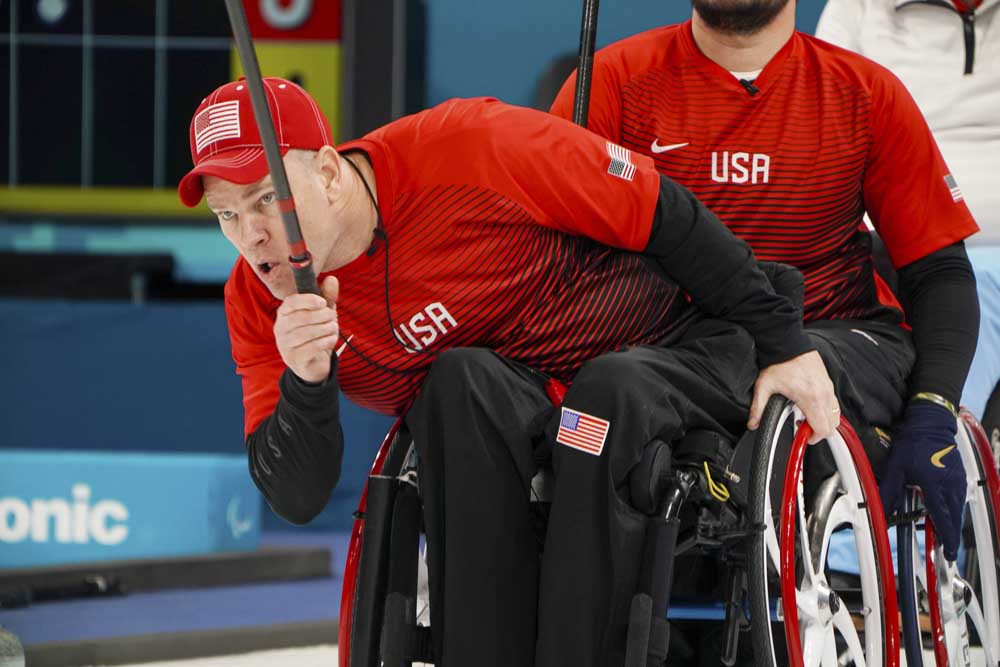Buoyed by financial support, veterans are a growing part of the Paralympics
Published 12:00 am Monday, March 19, 2018

- Kirk Black, of the United States wheelchair curling team, at the 2018 Paralympic Games in Pyeongchang, South Korea, March 15, 2018. The team's coach said the American Paralympic team was moving toward becoming disproportionately composed of military veterans because of the funding that veterans are eligible for and civilians are not. (Chang W. Lee/The New York Times)
Rusty Schieber, the U.S. wheelchair curling coach, has a theory about the future of the American Paralympic movement. It echoes the past.
The Stoke Mandeville Games, the forerunner of the Paralympics, were established in 1948 to restore a sense of purpose to veterans and civilians injured during World War II. As exposure and opportunities increased, U.S. veterans developed a deep connection to the Paralympics, assuming progressively prominent roles on Team USA.
Trending
They accounted for 24.3 percent (18 of 74) of the American roster in Pyeongchang, South Korea, at the 2018 event, which ended Sunday with the United States atop the medals table with 36. Veterans were 22.5 percent (18 of 80) of the team four years ago in Sochi, Russia, and 10 percent (five of 50) eight years ago in Vancouver, British Columbia. As Schieber sees it, those figures will only swell in the coming years — even as worldwide conflicts have declined — for one reason.
“It’s moving toward an organization disproportionately composed of military veterans because of the funding that veterans are eligible for and civilians are not,” Schieber said.
In many cases, pursuing Paralympic glory places a financial strain on American athletes, who receive sport-specific stipends from the U.S. Olympic Committee but also seek out grants and hold fundraisers to offset costs associated with travel and equipment. All that also applies to veterans. But at every stage of the process, from their introduction to a sport to competing in it on an international level, they are eligible for assistance that further subsidizes their quest.
“Thankfully we’re not getting as many kids blown up as we used to, but there are more avenues for the veterans to get some of those financial burdens lifted,” said Nico Marcolongo, senior manager of Operation Rebound, a program for veterans and emergency medical workers affiliated with the Challenged Athletes Foundation. He added, “If all things are equal, it’s harder for a nonveteran to get their start and get their resources than it would be for a veteran.”
Schieber, who served in the Air Force from 1985 to 1992, has no patience for those who criticize the imbalance, but he is aware of it. The uneven playing field has ramifications on recruiting, roster composition and team dynamics; Schieber suggested that in the past he needed to quell resentment over the discrepancy. None of the five curlers on the 2018 team, two of whom served in the Army, indicated in interviews that there was anything close to a rift.
“That athlete can train almost full time, in effect,” said Schieber, acknowledging that the athlete might then improve at a faster rate than a civilian. “We’re not paying him to be an athlete, but he’s getting totally subsidized by a third party, the U.S. government. He can live a pretty good financial life. He doesn’t have to have that second job. It’s hugely unlevel, but I don’t care. If you’re a veteran, take every penny you can get.”
Trending
The biggest help comes from the monthly allowance provided by the Department of Veterans Affairs, which is given only to athletes who are training or competing at a high level as defined by their sport’s governing body. A Veterans Affairs spokesman said 16 of the 18 veterans on the U.S. team at Pyeongchang received an allowance.
Based on the number of dependents in the athlete’s family, that monthly stipend ranges from $617 to more than $1,100. Any veteran who receives the allowance, then, automatically makes at least $7,400 more per year than a civilian on the same team.
Before they are eligible to earn this extra money, veterans first must be exposed to a sport. From his experience, Schieber said, veterans who want to participate in outreach camps around the country can have their expenses covered by VA hospitals or private organizations. Then they must unearth sources of funding that abet their continued involvement.
Often, veterans turn to organizations like Operation Rebound — which awards an average of $1,500 in need-based grants to athletes, regardless of skill level, whose applications are accepted — and the Semper Fi Fund.
Jimmy Sides, a former Marine, was introduced to snowboarding through the Walter Reed National Military Medical Center in Maryland, which offered trips to places like Breckenridge, Colorado. Calling his advantage “almost unfair,” Sides said Semper Fi provided almost all of his funding to compete, paying for gear, registration costs and race fees.
“I feel bad for the guy that loses his leg in a motorcycle accident or the cancer patient that loves snowboarding and wants to do this but has to struggle and grind,” Sides said.
On the curling team, Justin Marshall, who did not serve in the military but said many members of his family did, works 40 hours a week as an architectural associate and spends about 20 hours practicing. Last year, he took about two months of unpaid leave and was responsible for costs of domestic travel.
In an interview at the Utica Curling Club in Whitesboro, New York, before the Paralympics, Marshall said his situation was hard, but he would never hold that against his teammates who were veterans.
“Almost every guy in my family served in the military, and I probably would have followed except I had my spinal cord stroke when I was 12,” he said. “It helps them, so I can’t be mad at them for it. I wish I had that extra funding, but I don’t, so I just try to find another way to take care of that.”
The U.S. Olympic Committee bases how much money to award sports in the Olympics and Paralympics on many factors, but above all success. It is unlikely that the wheelchair curlers, who have yet to medal since the sport was added in 2006 and finished in last place Pyeongchang out of 12 nations, will receive more money than in the past. And so Schieber, to improve the team’s fortunes in the future, might be more likely to recruit as many military veterans as possible: He knows that they would more likely be able to afford the expenses to compete.
“If I’m looking at two athletes that are absolutely equal, does it fall into my mind that the veteran may have the better opportunity for funding and may be long term a better athlete down the road?” Schieber said. “You hate to say it. That’s a rhetorical question. I can’t give you an answer.”








